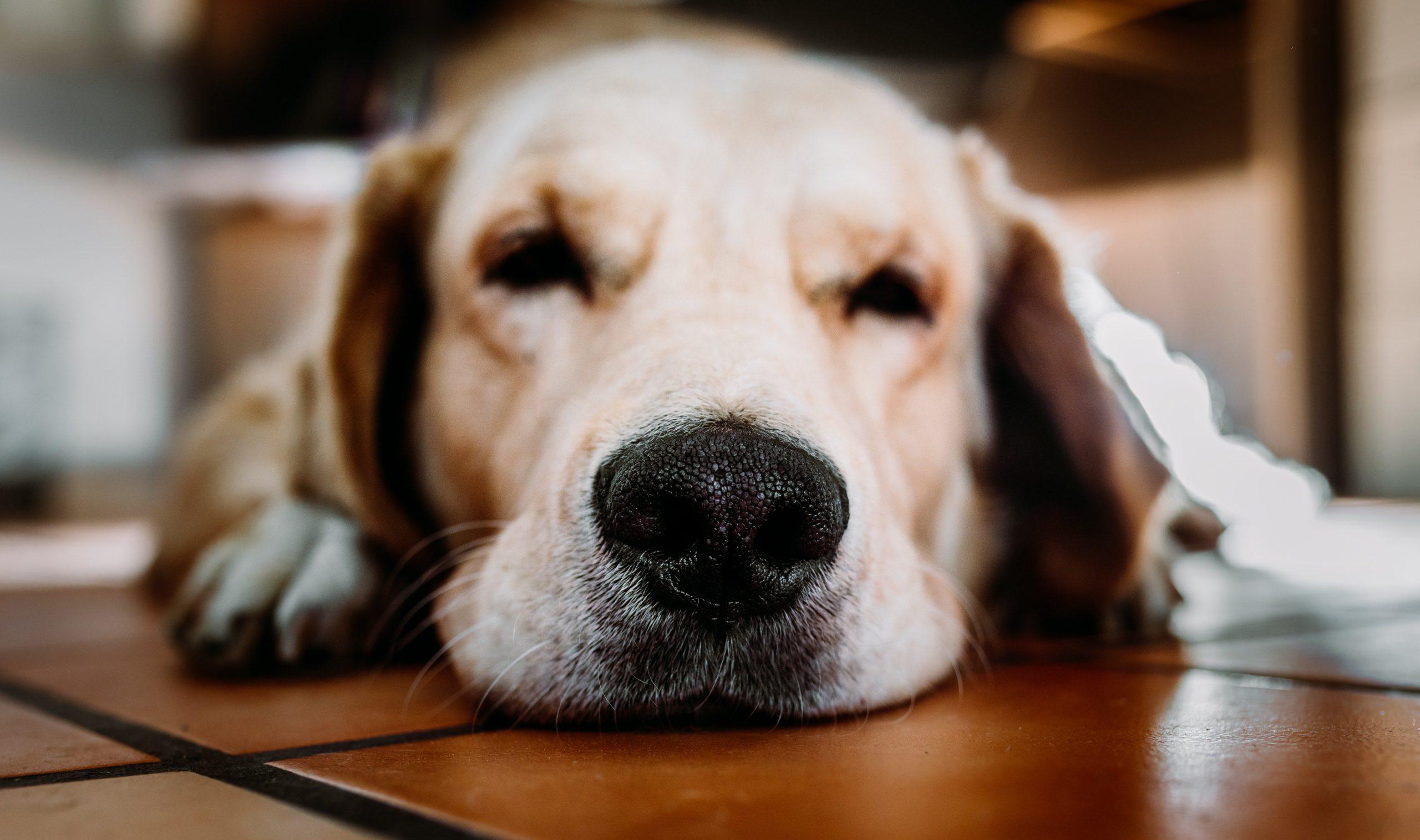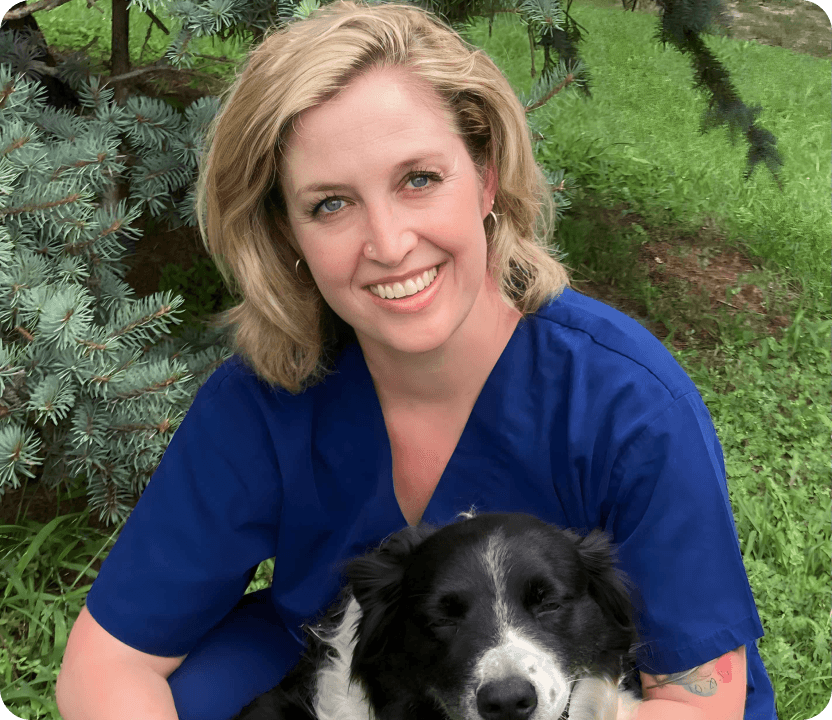What does it mean if a dog’s nose is dry? In this blog we learn all about why some dogs’ noses are dry and how to help keep it healthy.
- Home/
- Dog/
- Health & Wellness/
- Why Is My Dog’s Nose Dry?
Why Is My Dog’s Nose Dry?

Have you ever panicked that your dog’s dry nose is a sign that something is wrong? Before you start to worry, there could be a few surprising reasons why your dog’s nose is dry.
There is a popular saying, “A wet nose means a healthy dog.” So, what does it mean when your dog’s nose is dry?
Your dog’s nose will change from wet to dry and cold to warm all throughout the day, so noticing a change in their nose isn’t too strange. However, there are some cases where you should be concerned.
How Should a Dog’s Nose Feel?
Why do dogs have wet noses? Well, the main reason your pup’s nose is wet, cold, and moist is because of a thin layer of mucus that helps them smell. Their amazing sense of smell is 10,000 – 100,000 times more powerful than our human noses. This thin layer of mucus draws in tiny particles to be assessed by your dog’s olfactory glands, absorbing the scents. So, when your dog is licking its nose, it is collecting all that sensory information to process its environment… clever, huh? So, a dog’s cold, wet nose is actually desirable!
But, if a dog’s wet nose is so important to their sense of smell, why does it get dry so often? Take a look at some of the most common reasons your dog’s nose might be on the dry side.

11 Reasons Your Dog’s Nose is Dry
1. Sleep
It’s extremely common for dogs to wake up with a dry nose. While your furry friend sleeps, they won’t lick their nose, naturally reducing the moisture on the nasal surface. Your dog’s nose should be back to normal a few minutes after waking up, once they start licking it again.
However, if it doesn’t, try to encourage your dog to drink some water, as they might be slightly dehydrated from their slumber.
2. The Weather
The changing seasons can be quite unkind to your dog. From cold winters to scorching summers, both kinds of weather can cause your furry friend’s nose to become dry.
Particularly during the winter months, we keep warm by turning our central heating on. With the warmer air circulating in our homes, our dog’s nose can become drier.
3. Age
The older your pooch gets, the drier their nose will become; it’s just a fact of life. Senior dogs produce less mucus, which can then dry out their nasal passages.
If you notice your dog’s nose getting a bit more on the dry side as they age, it could be a good idea to invest in a dog-specific nose balm. This will help keep their nose moist and healthy!
4. Breed
Some dog breeds are a lot more prone to a dry nose. Pugs and Bulldogs have different shaped heads compared to other dogs (known as brachycephalic), and this can make licking their nose a little more difficult due to their shorter snout. So, if you’re the owner of one of these breeds, you may have to moisten it for them once in a while.
A warm, dry dog nose shouldn’t cause too much trouble, but if it starts to crack and become sore, that is when you will need to intervene and apply a nose balm or chat with your veterinarian.
5. Autoimmune Disease
While a dry nose doesn’t always indicate a serious issue, it can sometimes be a symptom of an underlying autoimmune disease. Autoimmune diseases occur when a dog’s immune system mistakenly attacks its own body tissues, leading to various health problems, including a dry nose. Two common autoimmune diseases that can cause dry nose in dogs are:
- Pemphigus: This group of autoimmune diseases affects the skin and mucous membranes, causing crusty sores, blisters, and ulcers. The nose is often one of the first areas to show symptoms, resulting in dryness and cracking. Dogs with pemphigus may also develop lesions around their eyes, ears, and mouth.
- Systemic Lupus Erythematosus (SLE): SLE is a more generalized autoimmune disease that can affect multiple organs and body systems. One of the signs of SLE can be a dry, scaly nose. Other symptoms may include joint pain, fever, and lethargy.
If you notice your dog’s nose is persistently dry and they show other signs of discomfort or illness, it’s crucial to consult with your veterinarian. They can conduct tests to diagnose underlying autoimmune conditions and recommend appropriate treatments to manage the disease and alleviate your dog’s symptoms. Early diagnosis and intervention are key to maintaining your dog’s health and well-being.
6. Dehydration
This is quite common in dogs, particularly during the hotter seasons. When your dog has had a bout of the zoomies at the park or around the yard, it can dehydrate them quite quickly if they don’t drink something soon after.
Make sure that your dog has plenty of fresh, cool water available to them. It is good to make yourself aware of the symptoms of dehydration as a puppy parent.
7. Seasonal Allergies
That’s right, dogs can have seasonal allergies too, just like humans. If you suffer from allergies, particularly during the summer months, you may notice that your own nose can get a little dry, crusty, and sore…well, it could be the same for your dog. If you’re a bit worried that their dry nose is due to seasonal allergies, speak to your veterinarian. They will be able to determine the cause of the dryness.
8. Blocked Tear Ducts
Blocked tear ducts, also known as nasolacrimal duct obstruction, can cause a dog’s nose to become dry. Tear ducts are responsible for draining tears from the eyes into the nasal cavity. When these ducts are blocked, tears cannot properly drain, leading to dry eyes and a dry nose.
This condition can cause discomfort and may lead to secondary infections if not treated promptly. Symptoms of blocked tear ducts include excessive tearing, discharge from the eyes, and a noticeably dry nose. If you suspect your dog has blocked tear ducts, consult your veterinarian for an appropriate diagnosis and treatment plan.
9. Sunburn
Dogs can get sunburn, especially in areas with little fur or pigmentation, such as the nose. Prolonged exposure to the sun’s UV rays can cause the skin on your dog’s nose to become dry, red, and flaky. Breeds with light-colored noses or thin fur are particularly susceptible to sunburn. To protect your dog from sunburn, limit their exposure to the sun during peak hours and use a pet-safe sunscreen. If your dog’s nose appears sunburned, provide shade and soothing balms (like those that contain aloe or vitamin E) to help it heal, and consult your veterinarian for further advice.

10. Nasal Hyperkeratosis
Nasal hyperkeratosis is a condition characterized by an overproduction of keratin, a protein that forms the outer layer of the skin. This leads to a thick, crusty buildup on the nose, making it appear dry and cracked.
The exact cause of nasal hyperkeratosis is not always known, but it can be associated with certain breeds, aging, or underlying health conditions. Regularly moisturizing your dog’s nose with a vet-approved balm can help manage this condition. If you notice persistent dryness and crusting, consult your veterinarian to rule out other underlying health issues and to discuss potential treatments.
11. Fever
A dry nose can sometimes be a sign that your dog has a fever. When a dog’s body temperature rises due to illness or infection, it can cause their nose to become warm and dry. Other symptoms of a fever may include lethargy, loss of appetite, shivering, and warm ears.
To check if your dog has a fever, carefully use a digital rectal thermometer to get an accurate reading; a temperature above 102.5°F (39.2°C) is considered a fever in dogs. If you suspect your dog has a fever, it’s important to seek veterinary care as soon as possible to identify the underlying cause and receive appropriate treatment.
Other Dog Nose Problems: Peeling, Cracking & More
While a dry nose in dogs is often harmless, it can sometimes be accompanied by other symptoms like peeling, cracking, crustiness, and even bleeding. These additional signs can indicate a more serious underlying issue that requires attention.
Peeling or Cracking
This often occurs when the skin becomes excessively dry, losing its natural moisture and elasticity. This can be due to environmental factors, such as exposure to harsh weather conditions, like cold winds or prolonged sun exposure, or from the dog frequently licking its nose, which can strip away natural oils. In some cases, a dry, cracked nose might also result from allergies to food, pollen, or certain chemicals found in household products.
Crustiness or Scabbing
Scabs or crusting is a response to the drying and cracking of the skin as the body tries to protect the sensitive underlying tissue. This can lead to a buildup of dead skin cells or even minor infections if the cracks are deep enough to allow bacteria to enter. Bleeding is a more severe symptom and usually indicates that the cracks or scabs have become deep enough to disrupt the blood vessels in the nose.
If your dog’s dry nose is accompanied by peeling, cracking, crustiness, or bleeding, it’s important to consult a veterinarian. These symptoms could be signs of more serious health issues, such as autoimmune disorders, infections, or other dermatological conditions that require professional diagnosis and treatment. Early intervention can help prevent further complications and ensure your dog’s nose stays healthy and comfortable.
Dog Dry Nose Treatment: How to Help
The treatment for a dog’s dry nose depends on the underlying cause of the dryness. Here are some common causes of a dry nose and the corresponding treatments:
Medication for Autoimmune Diseases
If an autoimmune disease is causing your dog’s dry nose, your vet may prescribe immunosuppressive drugs or other medications to manage the condition. Treatment aims to reduce the immune system’s attack on the dog’s own tissues, thus alleviating symptoms like a dry nose.
Addressing Dehydration
If dehydration is the cause of your dog’s dry nose, ensuring your dog drinks enough water is crucial. Incorporating wet food into your dog’s diet can also help increase their water intake. In severe cases, your veterinarian might administer fluids intravenously.
Treating Blocked Tear Ducts
For blocked tear ducts, your veterinarian may flush the ducts to clear the obstruction or prescribe medication to reduce inflammation. Surgery might be necessary in severe cases.
Protecting Against Sunburn
If sunburn is the issue, keep your dog out of direct sunlight during peak hours (typically between 12 and 4 p.m.) and apply pet-safe sunscreen to their nose and other sensitive, hairless areas. If the nose is already sunburned, soothing balms can aid healing.
Managing Nasal Hyperkeratosis
For nasal hyperkeratosis, regular application of a vet-approved moisturizing balm can help soften the keratin buildup and keep the nose moist. Your veterinarian may also recommend other treatments if the condition is severe.
Treating Fevers
If your dog’s dry nose is due to a fever, treating the underlying infection or illness is essential. Your veterinarian may perform diagnostics such as bloodwork and prescribe antibiotics or other medications to reduce the fever and address the root cause.

What Can I Put on My Dog’s Dry Nose?
There are several safe and effective options for moisturizing your dog’s dry nose. However, not all products are safe, so it’s essential to choose carefully.
Safe Options for Moisturizing Your Dog’s Nose
Nose Balm: Specially formulated dog nose balms are the best option for treating a dry nose. These balms are designed to be safe if licked and contain ingredients that hydrate and soothe the skin.
Coconut Oil: Coconut oil is safe for dogs and can be used to moisturize a dry nose. It has anti-inflammatory and antibacterial properties, making it beneficial for minor irritations.
Olive Oil: Olive oil is another safe and natural option. It’s rich in antioxidants and can help moisturize and heal a dry nose.
Products to Avoid
Vaseline: While Vaseline (petroleum jelly) is effective at moisturizing, it is not recommended for dogs because it can be harmful if ingested. Dogs often lick their noses, and ingesting petroleum jelly can lead to stomach upset or more severe health issues.
Human Skin Care Products: Many human skin care products contain ingredients that are toxic to dogs. Always choose products specifically formulated for pets.
Essential Oils: Some essential oils can be toxic to dogs, especially if ingested. Avoid using any products with essential oils unless they are specifically formulated for canine use and approved by your veterinarian.
How to Prevent Dry Nose in Dogs
So, can you take steps to prevent your dog(s) from developing a dry nose? While some causes, such as autoimmune diseases, cannot be entirely prevented, there are several proactive measures you can take to help keep your dog’s nose healthy.
- Keep Your Dog Well Hydrated: Dehydration is a common cause of dry noses in dogs. Ensure your dog has constant access to fresh, clean water, especially during hot weather or after physical activity. A well-hydrated dog is less likely to experience dryness or cracking on their nose.
- Manage Allergies and Avoid Triggers: If your dog has known allergies, managing them effectively can help prevent a dry nose. Work with your veterinarian to identify and avoid allergy triggers, whether they are food-related, environmental, or due to specific substances. Keeping your dog away from allergens can reduce the likelihood of skin and nose issues.
- Protect Your Dog from the Sun: Just like humans, dogs can suffer from sunburn, particularly on sensitive areas like their nose. If your dog spends a lot of time outdoors, consider using pet-safe sunscreen on their nose or limiting their sun exposure during peak hours. Providing shade and ensuring they have a cool place to rest can also help.
- Feed a High-Quality Diet: Nutrition plays a crucial role in the overall health of your dog’s skin and nose. A diet rich in essential fatty acids, vitamins, and minerals supports healthy skin and coat, which includes the delicate skin on the nose. Opt for high-quality dog food that meets your pet’s nutritional needs to help keep their nose supple and moist.
- Use a Humidifier: If you live in a dry climate or during the winter months when indoor heating can dry out the air, using a humidifier can help maintain moisture in your dog’s nose. This simple step can make a significant difference, particularly for dogs prone to dryness.
By taking these preventative measures, you can help reduce the risk of your dog developing a dry nose and ensure they stay comfortable and healthy. However, if you notice persistent dryness or other concerning symptoms, it’s always best to consult your veterinarian for further advice.
Final Thoughts on What Does a Dry Nose on a Dog Mean
So, if your dog’s nose is changing from dry to wet and cold to warm throughout the day, it’s usually nothing to worry about. Your dog is still a healthy pooch – great news!
You can ignore the rule – “a dry nose means your dog is sick”. Just keep an eye on their overall health and keep them hydrated in the summer months. Other than that, a dry nose isn’t the end of the world, so try not to worry too much about it unless it’s cracked, bleeding, or very sore. Then, you’ll need to check in with your veterinarian as soon as possible.
Sources
jenAuthor Reisin, Jan “Warning Signs Of Dehydration In Dogs” American Kennel Club, Jun 29. 2021 https://www.akc.org/expert-advice/health/warning-signs-dehydration-dogs/
 B
B




